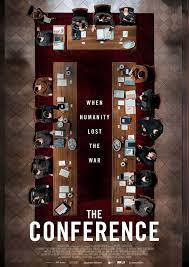
THE CONFERENCE/ DIE WANNSEEKONFERENZ
Germany, 2022, 108 minutes, Colour.
Philipp Hochmair, Johannes Allmayer, Maximilian Bruckner, Godehard Giese.
Directed by Matti Geschonneck.
80 years ago, January 1942, over two years since the outbreak of World War II, a month after the bombing of Pearl Harbor, German forces advancing on Moscow, the head of the security police, based in Prague, Reinhard Heydrich, calls a conference of 15 Nazi authorities to his Schloss on Lake Wannsee, south-west of Berlin, scheduled for only 90 minutes, with some refreshment breaks.
For many, this is the most sinister conference in world history. Someone labelled it “a blueprint for genocide”. The item on the agenda was “The Final Solution to the Jewish Question”. And the theory for further action was finalised under the 90 minutes, the repercussions, the Holocaust, the atrocity of the 20th century.
The conference was filmed for German television in 1984 with the same title, a brief but effective film, based on notes and minutes, communicating the tone and reality of the conference. There was a version for four US/UK television, Conspiracy (2001), powerful in its impact with the same intense dialogue, but with Kenneth Branagh as Heydrich and Stanley Tucci as Eichmann.
This film requires close attention, listening to the words, looking at the body language of those participating. Heydrich as the presider, Hail-fellow-well-met manner, welcoming everyone, a measured kind of smile on his face, the perfect host, absolutely confident in what he was to achieve and how to achieve it, facilitating the discussions and the arguments, going into private consultations with some of the group, happily concluding the agenda to his liking.
(Older audiences and filmgoers will know that Heydrich was called by Hitler, “the man with the iron heart” (the title of one of the films about him). He had been Hitler’s pick for eliminating those against the Nazi regime, and especially organising Kristallnacht. Within five months, back in Prague, the local resistance had ambushed him, fatally wounded him. And there were reprisals where villages were destroyed, inhabitants slaughtered. There have been many films and television programs on this issue, even from Hollywood during the war years.)
While it may be difficult to remember who each of the members of the Conference is and what they represent, they are introduced, the audience having a chance to listen to their talk, friendships, rivalries, animosities, to look at their faces, their appearances, how they sat at the desks, how they intervened.
We soon realise if we haven’t quite remembered, that each of the men (and there was a female notary) takes it for granted that Jews were the enemy, and disrupted finances, were overturning society, and, of course, the whole issue of Aryan supremacy and racial contamination. We might be amazed, but should not be amazed, at watching all these men, taking for granted that the Jews were evil and that they should be eliminated. They are generally cool, calmly steeped in their attitude, would not think describing it in any way as racist or prejudiced. For them, this is the situation to be addressed – and Heydrich notes that they are the generation with to the task to achieve this.
While Heydrich smiles, there is no humour or leeway in Eichmann’s character. He is certainly the “intelligence” behind the Final Solution, he comes across as the complete, straightforward, but detail- nuanced, bureaucrat. He has all the information, he has all the statistics, ready to quote without consultation.
(And, watching Eichmann in this film, many will be thinking of where he was 20 years later, the hunting down in Argentina, his being returned to Jerusalem, the trial of the “man in the glass booth”, his being denounced, the details of the denunciation, leading to his execution.
Watching these men, proud of their power and influence, arguing their cases, some almost prim, enjoying their coffee breaks and the salmon being served, we remember that Hannah Arendt spoke of “the banality of evil”.)
Watching this film and listening to the dialogue, requires great concentration, but several characters do stand out, especially Dr Stuckart, who framed a great deal of the legislation against the Jews, a lawyer with absolute rigidity of relying on the law, continually arguing his case, but neatly cajoled by Heydrich into agreeing with him in a private conversation.
There is also the doctor who seems a humanitarian, no scruple in the elimination of the Jews, but giving statistics of how long it would take German soldiers to shoot the thousands, hundreds of thousands, to be eliminated, the amount of blood, the psychological effect disturbing the German soldiers. When Eichmann reveals the gas solution, he agrees that this is the most humane method, the least disturbing effect on the soldiers executing.
It was that kind of conference.
Heydrich and Eichmann had solutions before they went in but needed the official conference, the official discussion, the raising of difficulties, the opportunity to explain all the logistics, the location of the camps, whether they were near towns or not, the transporting of the Jews, the role of women and children, (a great deal of legal discussions about percentages of Jewish blood and of Aryan-Jewish marriages), what kind of trains, passenger or freight, the transition from railway station to gas chambers, the transporting of the gas… Yes, a blueprint for genocide.
While The Conference may not be attractive for night out of the cinema, one hopes that it will be viewed by large audiences on television, that it will be a significant resource for those studying the history of World War II, Nazism, the “Jewish Question”, the Holocaust.